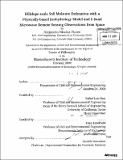Hillslope-scale soil moisture estimation with a physically-based ecohydrology model and L-band microwave remote sensing observations from space
Author(s)
Flores, Alejandro Nicolas
DownloadFull printable version (117.7Mb)
Other Contributors
Massachusetts Institute of Technology. Dept. of Civil and Environmental Engineering.
Advisor
Rafael Luis Bras and Dara Entekhabi.
Terms of use
Metadata
Show full item recordAbstract
Soil moisture is a critical hydrosphere state variable that links the global water, energy, and carbon cycles. Knowledge of soil moisture at scales of individual hillslopes (10's to 100's of meters) is critical to advancing applications such as landslide prediction, rainfall-runoff modeling, and wildland fire fuel load assessment. This thesis develops a data assimilation framework that employs the ensemble Kalman Filter (EnKF) to estimate the spatial distribution of soil moisture at hillslope scales by combining uncertain model estimates with noisy active and passive L-band microwave observations. Uncertainty in the modeled soil moisture state is estimated through Monte Carlo simulations with an existing spatially distributed ecohydrology model. Application of the EnKF to estimate hillslope-scale soil moisture in a watershed critically depends on: (1) identification of factors contributing to uncertainty in soil moisture, (2) adequate representation of the sources of uncertainty in soil moisture, and (3) formulation of an observing system to estimate the geophysically observable quantities based on the modeled soil moisture. Uncertainty in the modeled soil moisture distribution arises principally from uncertainty in the hydrometeorological forcings and imperfect knowledge of the soil parameters required as input to the model. Three stochastic models are used in combination to simulate uncertain hourly hydrometeorological forcings for the model. Soil parameter sets are generated using a stochastic approach that samples low probability but potentially high consequence parameter values and preserves correlation among the parameters. The observing system recognizes the role of the model in organizing the factors effecting emission and reflection of L-band microwave energy and emphasizes the role of topography in determining the satellite viewing geometry at hillslope scales. (cont.) Experiments in which true soil moisture conditions were simulated by the model and used to produce synthetic observations at spatial scales significantly coarser than the model resolution reveal that sequential assimilation of observations improves the hillslope-scale near-surface moisture estimate. Results suggest that the data assimilation framework is an effective means of disaggregating coarse-scale observations according to the model physics represented by the ecohydrology model. The thesis concludes with a discussion of contributions, implications, and future directions of this work.
Description
Thesis (Ph. D.)--Massachusetts Institute of Technology, Dept. of Civil and Environmental Engineering, 2009. Includes bibliographical references (p. 469-488).
Date issued
2009Department
Massachusetts Institute of Technology. Department of Civil and Environmental EngineeringPublisher
Massachusetts Institute of Technology
Keywords
Civil and Environmental Engineering.